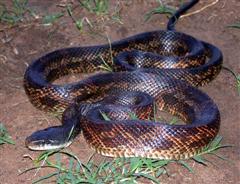Rat Snake - Black
Pilot Snake, Chicken Snake Scientific Name: Elaphe obsoleta
Thu, 17th April, 2025 - 9:49 am GMT
Sponsor Ads:

Alternative Name
Pilot Snake, Chicken Snake Scientific Name: Elaphe obsoletaBasic Info
The Black Rat Snake is really quite large, averaging four to six feet in length, though some especially huge examples have grown to eight feet. As the name implies, the Black Rat Snake is mostly black, although in infancy these snakes are a lighter color, often gray, with patterns on them in gray, red, or brown. These patterns are retained in adulthood and may be seen faintly in the adult black scales.
Health
Breeding Female Pilot Snakes usually reproduce once every two years, and lay clutches of 9 to 21 eggs. They use clumps of rotting or dead plants as nesting sites. Several females will use the same nesting site. The Black Rat Snake breeds between April and June, and the clutch is laid after a gestation period of 35 to 51 days.Habitat
The Black Rat Snake is a diurnal reptile, which prefers wooded lands and open meadows, especially previously farmed fields.Behavior
The Canadian Black Rat Snake, also known as the Pilot Snake or Chicken Snake, is a North American member of the constrictor family. In the warmer months these snakes will sometimes form nocturnal habits. Black Rat Snakes prey primarily on rats and mice, although on occasion they have been known to eat birds as big as small chickens. This is the reason it is known also as the Chicken Snake. Black Rat Snakes are very good climbers and like trees containing bird eggs and the occasional bird. Though normally solitary creatures, in the winter, Black Rat Snakes hibernate in spaces called 'hibernacula' with other species of snakes as well as other Rat Snakes. Usually a hibernaculum will contain 30 to 50 snakes from October until about April. Long ago it was thought that if venomous snakes like rattlers were in danger, the Black Rat Snake would lead them to safety, and in many areas it is called the Pilot Snake for this reason. Black Rat Snakes are non-venomous, but are often mistaken for copperheads or rattlesnakes because of their defensive behaviors. When frightened, the Pilot Snake will coil itself, strike at the danger, rapidly shake its tail, and hiss. The Black Rat Snake also has glands, which can emit a disgusting odor if the snake is picked up. These powerful but peaceful snakes can live up to twenty years in the wild.Origin
North AmericaHistory
The Black Rat Snake is native to parts of North America though its largest range is in the United States. Unfortunately the Black Rat Snake is now endangered in Canada. The decrease in their numbers is due to a variety of factors; among these are hunting and trapping for the pet trade and habitat destruction. Much of their natural range has been destroyed by development. Their range has been restricted to two very small habitat paths in Canada. These lie in the Kingston area and along the shore of Lake Erie. Today these snakes are protected by law and in Canada it is illegal to keep them as pets without the proper ministry permits. Additionally, because many people are afraid of snakes, they are often killed on sight. If the Black Rat Snake is lost in Canada, the rodent and bird populations, which it usually controls, will boom and its useful pest control function will be lost, in addition to the loss of a beautiful creature. Luckily, even though the Black Ratsnake may be threatened in Canada the largest portion of its range is in the eastern United States. This is still a very common snake from Pennsylvania to the mountainous regions of the Carolinas and west to Oklahoma and Illinois. It is readily available in the United States away from the periphery of its range.Common Foods
Black Rat Snakes prey primarily on rats and mice, although on occasion they have been known to eat birds as big as small chickens.Sponsor Ads:
"I know not with what weapons World War III will be fought, but World War IV will be fought with sticks and stones." -- Albert Einstein
Rat Snake - Black
Coded by: BGID® | ALL RIGHTS RESERVED Copyright © 2000-2025
Disclaimer | Privacy | Report Errors / Contact | Credits








 President of the United States of America - Real Estate mogul, Pageant owner and now one of the most controversial men in political history.
President of the United States of America - Real Estate mogul, Pageant owner and now one of the most controversial men in political history.  Politician, US Vice President and President of the USA - Joseph Robinette Biden Jr.
Politician, US Vice President and President of the USA - Joseph Robinette Biden Jr.  versus
versus  Russia: 'The Evil Empire'? Are they all that bad or is it just the USA trying to portray Russia as bad because they are a world power with land bigger and a society very different from the USA ideal?
Russia: 'The Evil Empire'? Are they all that bad or is it just the USA trying to portray Russia as bad because they are a world power with land bigger and a society very different from the USA ideal?  Global warming has been in and out as the "latest" hot topic for many years. It is, according to modern scientists, the result of man-made industrial pollutants, clearing forested areas, agriculture, etc. But now they are thinking it started way before the Industrial Revolution...
Global warming has been in and out as the "latest" hot topic for many years. It is, according to modern scientists, the result of man-made industrial pollutants, clearing forested areas, agriculture, etc. But now they are thinking it started way before the Industrial Revolution... 
 Corona virus
Corona virus 
 Users with wide screen monitors can benefit from more content on every page.
Users with wide screen monitors can benefit from more content on every page.